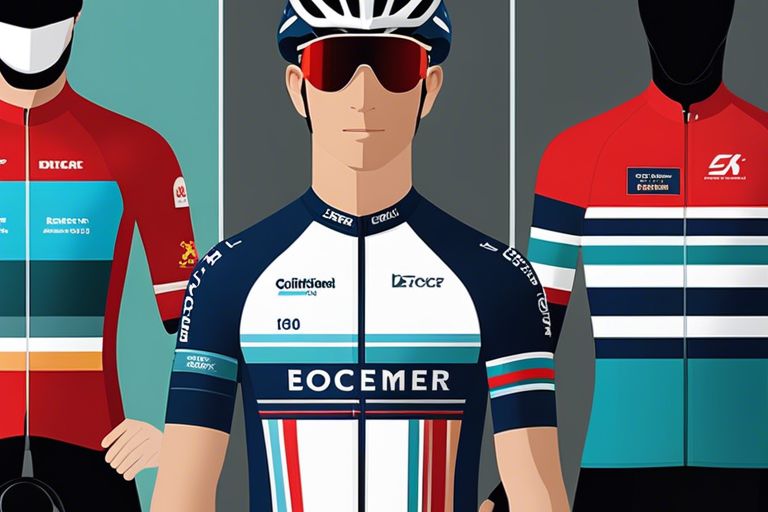Cycling jerseys have a rich history that dates back to the early days of the sport, evolving from simple wool garments to high-tech, performance-driven pieces of apparel. Over the years, cyclists have not only relied on jerseys for functionality but also used them as a canvas for expressing team identity and personal style. In this blog post, we will explore the fascinating journey of cycling jersey designs, from classic looks to modern innovations, uncovering the trends and technologies that have shaped this crucial piece of cycling gear.

Key Takeaways:
- Functionality: Cycling jersey designs have evolved to prioritize functionality, with features such as moisture-wicking fabrics, aerodynamic cuts, and breathable materials to enhance performance.
- Technology: Advancements in fabric technology have revolutionized cycling jerseys, with the introduction of lightweight, stretchable, and quick-drying materials for optimal comfort and performance.
- Visibility: Modern cycling jerseys often incorporate high-visibility colors and reflective elements for improved visibility and safety on the road, especially in low-light conditions.
- Personalization: Cyclists now have the option to personalize their jerseys with custom designs, team logos, and sponsorships, adding a unique touch to their cycling apparel.
- Fashion: Cycling jersey designs have also seen a shift towards incorporating fashion-forward trends, making them not only functional but also stylish for cyclists to express their individuality while riding.

The Beginnings of the Cycling Jersey
The Early Days: Wool and Practicality
Early cycling jerseys were primarily made of wool due to its natural moisture-wicking properties and durability. These jerseys, often in neutral colors, were designed with practicality in mind, focusing on functionality rather than style. They were loose-fitting to allow for movement and typically had a quarter-zip at the front for ventilation.
Function Over Form: Pockets, Zippers, and Collars
Early cycling jerseys featured pockets at the back to store necessarys like a map, food, or repair tools, making them ideal for long rides. Zippers on the front of the jerseys allowed cyclists to adjust ventilation as needed, while collars provided protection against the elements. These design elements were all about functionality and convenience.
Beginnings: As cycling grew in popularity and competitions became more intense, the need for specialized gear became apparent. Cycling jerseys evolved to meet the demands of riders, incorporating features that enhanced performance and comfort on the bike. The early focus on functionality laid the foundation for the innovative designs we see in modern cycling jerseys.
The Shift Towards Synthetic Fabrics
While cotton was a popular choice for early cycling jerseys due to its breathability, comfort, and affordability, the shift towards synthetic fabrics revolutionized the cycling apparel industry. Synthetic materials offered improved moisture wicking abilities, breathability, and durability, making them ideal for high-performance cycling gear.
Polyester Revolutionizes Comfort and Performance
Shift: The introduction of polyester in cycling jerseys marked a significant turning point in the evolution of cycling apparel. Polyester fabric is lightweight, quick-drying, and has excellent moisture-wicking properties, making it perfect for intense rides and hot weather conditions. Cyclists experienced enhanced comfort and performance, as the fabric efficiently drew sweat away from the skin, keeping them cool and dry throughout their rides. Polyester jerseys also proved to be more durable than their cotton counterparts, standing up to the rigors of cycling and frequent washings without losing shape or color.
FAQ
Q: How have cycling jersey designs evolved over the years?
A: Cycling jersey designs have evolved significantly over the years. Initially, jerseys were made of wool and were heavy and uncomfortable. However, with advancements in fabric technology, modern cycling jerseys are now made of lightweight, breathable materials that offer moisture-wicking properties to keep cyclists dry and comfortable during their rides.
Q: What are some key features of modern cycling jerseys?
A: Modern cycling jerseys are designed with performance and comfort in mind. They feature aerodynamic cuts to reduce drag, mesh panels for ventilation, and a snug fit to reduce wind resistance. Additionally, many jerseys now come with pockets on the back to store crucials such as energy gels, keys, and a phone.
Q: How have advancements in technology influenced cycling jersey designs?
A: Advances in technology have played a major role in shaping the evolution of cycling jersey designs. Technical fabrics such as Lycra and polyester have revolutionized the way jerseys fit and feel. These materials offer stretch, breathability, and moisture-wicking capabilities, making modern cycling jerseys a staple for both professional riders and recreational cyclists.




